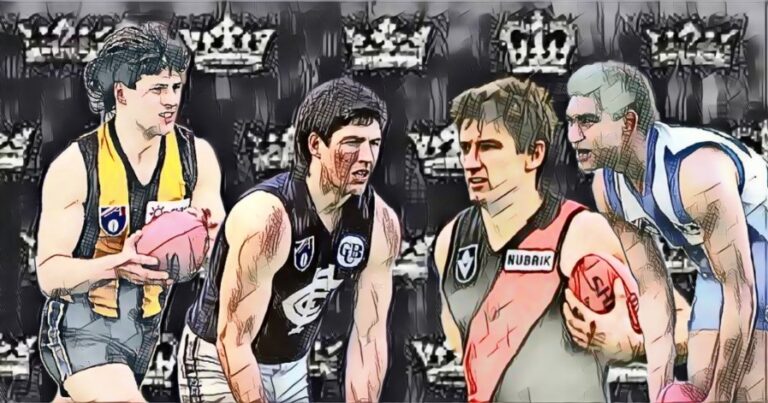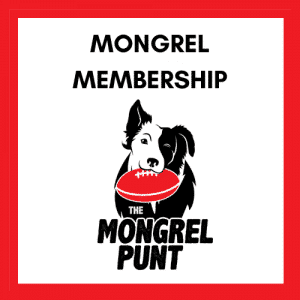There are some players who stand out in our memories and many of us, myself included, have lionised them over the years, making them seem grander than perhaps they really were.
The AFL Hall of Fame is littered with players who excelled at the highest level and achieved enormous feats of brilliance on the field, but not all players we’ll cover here will have been announced as part of the game’s elite.
Here at The Mongrel Punt, we have always endeavoured to look a little beyond the obvious, flitter between household names and some that maybe… just maybe have slipped your mind over the years.
In this series profiling the heroes of the game, we look at some of the players who were vital to their teams’ success in different capacities.
And believe me – there are plenty of them. And we ask – just how good were they?
STEPHEN KERNAHAN
When Jordan Dawson arrived at Adelaide in 2022, not many saw him being appointed skipper just 12 months later. I mean, how often does it happen that an outsider comes in and is so impressive that they assume responsibility so quickly?
Chris Judd did it at Carlton, and the other bloke to do it was Stephen Kernahan, who stepped into the role of captain after just one year in the famous navy blue guernsey.
Kernahan’s ability as a leader saw him guide the Blues to the flag in his first year at the helm, and his rendition of ‘stand by your man’ in celebration of the win still haunts him to this day.
However, it was Kernahan’s exceptional marking ability and goal sense that made him such a force in the then-VFL and into the AFL years. He had already led his SANFL team, Glenelg, in goalkicking for two years, and displayed his talents to the rest of the country in the 1984 State of Origin carnival, that saw him kick ten goals against Victoria in a losing team. If the wider footy world didn’t know Kernahan before that day, they did when he continually stood up against the likes of Bruce Doull, Gart Pert, Chris Mew, and Jimmy Jess, going close to dragging SA over the line
This game is well worth a look – a tight contest, with the young Kernahan really making his presence felt in such a way that you wonder had he left the SANFL a couple of years earlier, could he have kicked 1000 V/AFL goals?
He finished on 738 in a sterling 12 years with Carlton, which saw former Carlton President, Ian Collins label him as “on and off-field, the greatest leader Carlton has ever had”.
You don’t just bestow those types of words on anyone.
MATTHEW LLOYD
Speaking of blokes who should have kicked 1000 goals, could you blame Matthew Lloyd for feeling a little resentment abut the way it all ended at Essendon?
Lloyd seemed to be a moral to become the sixth man to reach the AFL forwards’ pantheon of greatness, joining Doug Wade, Gary Ablett Senior, Jason Dunstall, Gordon Coventry, and Tony Lockett as the men to have climbed Mount 1000.
And then Matthew Knights happened along as the new coach, replacing Kevin Sheedy, and decided Lloyd would be better suited playing another role – spending his time outside the forward fifty and working up to the wings.
Meanwhile, Knights placed his faith in Jay Neagle to get the job done as the stay-at-home forward.
Yep… the same Jay Neagle who played a total of 28 games and kicked 41 goals.
What a disaster.
Lloyd went from being an integral part of the red and black machine to a spare part on the workshop floor. Looking back and knowing what Lloyd was capable of compared to what the collection of Neagle, Scott Gumbleton, and Jason Laycock produced, there is no question that Lloyd was prevented from reaching not only 1000 goals, but also 300 games by the appointment of Knights and his idea of shaking things up at Essendon.
The best mark-kick man in the game since Jason Dunstall, the way Lloyd finished was a disgrace and whether you like him or not, a player of his calibre, particularly with a fair bit left to give, should have been hailed as one of the greatest forwards the game has seen. And he should’ve joined that 1000 club.
Instead, we had it end the way it did. A massive shame.
DARRIN PRITCHARD
When Jason Dunstall names you as the player he enjoyed leading to the most, you know you’ve been doing something right. Hell, the bloke played with Darren Jarman!
Darrin Pritchard’s ability to put the footy right where Dunstall wanted it assured that his spot in the Hawthorn team was always secure. An elite runner and supremely skilled, Pritchard would often be the beneficiary of the Hawks’ rebound out of defence, playing a kick behind the play and always ready to turn on the jets and race down the wing.
The thing I always noticed about Pritchard was that, despite being an elite kick of the ball, he didn’t try to kill the footy when he kicked it to his forwards. It was always a measured, weighted kick out into space, almost as though he dictated where the forward needed to lead to as much as he responded to the leading patterns of players like Dunstall and Brereton.
He was arguably at his absolute best through the tail-end of the Hawthorn golden era, from 1989-91, as his hard run and delivery stretched defences and usually meant that playing an attacking wingman on him was going to hurt you going the other way.
He retired in 1997, playing 211 games for the Hawks and making everyone around him look good with his precision.
SIMON MADDEN
Sometimes, it takes something being put to you a little differently for you to truly understand it.
I always rated Madden highly. I thought he was probably the best ruck I’d seen, in terms of being able to go forward and play as a legitimate target, but in listening to a podcast a couple of years back, I heard Sam Newman and Don Scott talking about just why Madden was so good in the ruck, and it was something I hadn’t considered.
Hearing two Hall-Of-Fame ruckmen, irrespective of what you think of them, talking about how technically brilliant Madden was in the way he could leap off either foot and tap with either hand gave me a new appreciation of his skills. So much so that I went back and watched a couple of vintage games to see just how often he changed things up.
The answer was simple – all the bloody time.
This must have been extremely disconcerting for his opponents as they tried to work out what Madden was planning to do. It also gave him a huge advantage inasmuch as it didn’t matter where the ball ended up after being bounced, he would be able to make a contest – and not just a “run in and make it difficult” type of contest, but win the tap and set up a teammate.
I grew up watching Madden play against Gary Dempsey in his North Melbourne years. At that time, Demps was slower and would position himself well around the ground. Madden would play more on the offensive side, often stretching the defence and making Dempsey retreat to the defensive end to cover him. It was like watching the master and the apprentice, and by the time Dempsey hung the boots up in 1984, the title of master already belonged to Madden.
575 goals as a ruckman… he was incredible.
ADRIAN MCADAM
Sometimes, it is not how long a candle burns, but how bright the flame that matters, and in 1993, no flame burned brighter than that of Adrian McAdam.
For McAdam, the flame was out of control in the 1993 season, as he burst onto the scene as part of an already-potent North Melbourne forward line.
Described by his brother, St Kilda defender Gilbert McAdam, as someone “who could play a bit”, the younger McAdam kicked seven goals on debut for the Kangaroos, forming a formidable three-headed monster with John Longmire and Wayne Carey that made North Melbourne the most fun team to watch in the league.
He followed up that effort with ten goals the next week, and six in his third game.
Imagine someone bursting onto the scene like that now, with 23 goals in their first three games? They’d be hailed as the footballing messiah! Particularly if they weren’t even a key position player.
In one of the strangest careers we’ve seen in footy, McAdam had 68 goals to his name at the end of the 1993 season. He would add just 24 more before it was all said and done, retiring from the game in 1996 after leaving North Melbourne amd signing on with Collingwood. He failed to register a game for the club.
Was he good?
Hell yes, he was good. I can remember watching him wondering what the hell was going on – it was like a party in the North Melbourne forward line in that brief period. But he couldn’t sustain it. Whether it was the demands of AFL life, the opposition coaches working him out, or something else entirely, that a talent like McAdam could shine so brightly, so briefly and then be gone highlights that this life is not for everyone and time in the spotlight, wanted or not, is fleeting.
Like this content? You could buy me a coffee – I do like coffee, but there is no guarantee I won’t use it to buy a doughnut… I like them more. And I am not brought to you by Sportsbet or Ladbrokes… or Bet365, or any of them.



